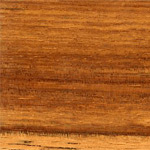Serving Upstate NY—VT—MA • For selections & prices, CALL or EMAIL US
Timborana
Wood Flooring Species
Scientific Name:
Piptadenia suaveolens or Enterolobium schomburgkii
Other Names and Species:
Acacia Franc
Angelium
Angico
Batibatra
Bougou Bati Batra
Coumarouna Odorata
Cobi
Galondrino
Harino
Hevio
Jebio
Menudito
Timbauba
Yellow Sucupira
Yiguire
Origin:
Central America and Brazil
Appearance:
The sapwood of timborana is yellow to cream-coloroed, while the heartwood is more of a light yellow with occassional darker streaks. The species has a straight or interlocked, sometimes wavy, grain. Timborana is referred to as medium-textured, lying somewhere between fine and coarse. Its luster in its raw state is low to medium in apperance.
Properties:
Timborana has a moderate resistance to fungus and termites. The wood remains smooth under friction and is reported to have no odor. Timborana dries at a slighly slower rate than some other species of wood.
Janka Hardness: 1570
As a flooring option, timborana is a hard and durable wood. It is within ten percent of hard maple’s hardness, about twenty percent harder than red oak, close to eighty percent as hard as jarrah, and roughly seventy-one percent as hard as santos mahogany’s ranking of 2200.
Workability:
Timborana can be slightly difficult to saw properly due to its hardness. Pre-boring is necessary to ensure proper nailing. Glue holds well with this flooring and this species requires some effort to sand properly.
Principal Uses:
Timborana’s uses include house framing, heavy carpentry, musical instruments, and furniture.
Learn more about available grades of
Timborana hardwood flooring »





